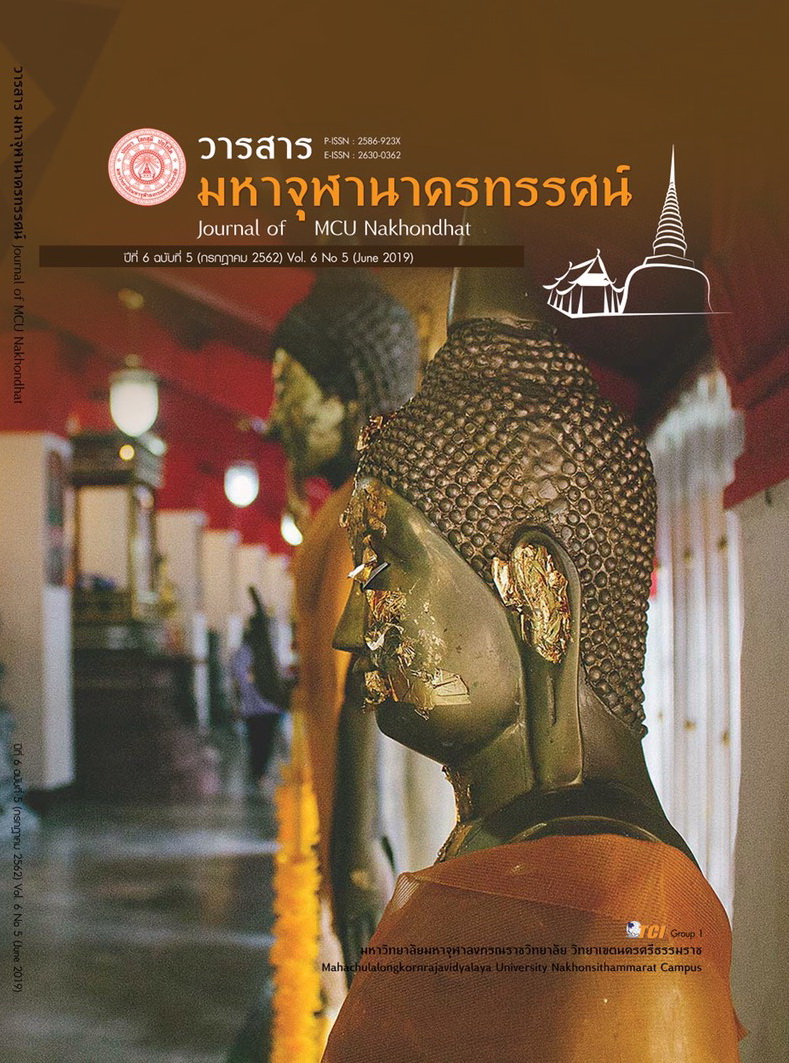ANALYSIS LANNA BUDDHIST ARTS AND RELATIONSHIP CREATIVE PROCESS WITH THE ETHNIC GROUPS MEAKHONG SUBREGION
Main Article Content
Abstract
This article is part of the dissertation entitled to " Lanna Buddhist Arts and Building up Relationship between the Ethnic Groups in Mea Khong Sub Region ". The objective is to study: 1) the history of lanna Buddhist Art, 2) the building up relationship between the Ethnic Groups in Mea Khong Sub Region through the lanna Buddhist Arts and 3) analyze the factors having caused the relation building between them. It was done by a documentary research and Field Research.
The results were found:
- The Lanna Buddhist arts had appeared since the 19th Buddhist Century by the Mangrai Dynasty Kings. These Buddhist arts had been influenced by two sources of Buddhist arts, i.e., 1) from the Buddhist Kingdom of Burma via Chiang Saen and Hariphunchaya Kingdoms, 2) from the Buddhist Kingdom of Lanka via the Sukhothai Kingdom. They had been developed during 150 years until the golden age of Buddhism in Lanna.
- The values of Lanna Buddhist arts had develop by 6 elements. They are 1) the Strength of the Army, 2) the Buddhist institutions, 3) the laws, 4) the Craftsmen, 5) the Agriculture 6) the Economy. These above-mentioned factors have played the influences of Buddhist Arts as the process in creating the relationships between the various ethnic groups in the Mea Khong Sub-region by many aspects such as: the politics and governance, the Buddhist beliefs, Society, culture, economy and technology.
3. The Lanna Buddhist arts had built up the relationship between the ethnic groups in the Mea Khong Sub region with the help of 11 important factors: they are 1) the politics and governance 2) the increase of populations, 3) the Buddhist beliefs, 4) the education, 5) the etymology, 6) society and tradition, 7) the ethnicity, 8) geography, 9) the trade and economy, 10) the transportation and tourism and 11) the technology.
Article Details
References
โกวิท เอนกชัย (เขมานันทะ). (2538). อันเนื่องกับทางไทย. กรุงเทพมหานคร: ปกเกล้าการพิมพ์.
เชษฐ์ ติงสัญชลี. (2558). ประวัติศาสตร์ศิลปะ อินเดียและเอเชียตะวันออกเฉียงใต้ รูปแบบพัฒนาการ ความหมาย. กรุงเทพมหานคร: มิวเซียมเพรส.
ธนธร กิตติกานต์. (2557). มหาธาตุ. นนทบุรี: โรงพิพ์มติชน ปากเกร็ด.
ธรณ์ ธำรงนาวาสวัสดิ์. (2555). พม่า (Myanmar Make a Wish). กรุงเทพมหานคร: บ้านพระอาทิตย์.
บุญชู โรจนเสถียร. (2548). ตำนานสถาปัตยกรรมไทย 2. กรุงเทพมหานคร: บริษัทโรงพิมพ์กรุงเทพฯ.
ปรุตม์ บุญศรีตัน. (2550). รูปแบบการตีความคัมภีร์ในพระพุทธศาสนาเถรวาท. ใน ดุษฎีนิพนธ์พุทธศาสตรดุษฎีบัณฑิต. มหาวิทยาลัยมหาจุฬาลงกรณราชวิทยาลัย.
ปัญญา เทพสิงห์. (2548). ศิลปะเอเชีย. กรุงเทพมหานคร: บริษัท แอคทีฟ พริ้นท์ จำกัด.
พระพรหมคุณาภรณ์ (ป.อ.ปยุตฺโต). (2552). กาลานุกรม พระพุทธศาสนาในอารยธรรมโลก. กรุงเทพมหานคร: สำนักพิมพ์ผลิธัมม์.
พิสิฏฐ์ โคตรสุโพธิ์ และคณะ. (2557). การถ่ายทอดศิลปะและวัฒนธรรมภูมิปัญญาล้านนาสู่สังคมโดยผู้ทรงภูมิปัญญาท้องถิ่น (The Parting and Teaching of Art and Culture, im the Tradition of Lan na Wisdom to Society by local Scholars). เชียงใหม่: นพบุรีการพิมพ์เชียงใหม่.
เพิ่มศักดิ์ วรรยางค์กูร. (2545). วิถีธรรมวิถีไทย. กรุงเทพมหานคร: อาร์ทลีย์ เพรส.
มหาจุฬาลงกรณราชวิทยาลัย. (2539). พระไตรปิฎกภาษาไทย ฉบับมหาจุฬาลงกรณราชวิทยาลัย. กรุงเทพมหานคร: โรงพิมพ์มหาจุฬาลงกรณราชวิทยาลัย.
มานพ ถนอมศรี. (2551). สุโขทัย อุทยานประวัติศาสตร์ มรดกโลก. กรุงเทพมหานคร: บริษัท พี พี เวิลด์มีเดีย จำกัด.
ระวิวรรณ โอฬารรัตน์มณี. (2558). รูปแบบบ้านเรือนของกลุ่มชาติพันธุ์ในอุษาคเนย์ (พิมพ์ครั้งที่ 3). เชียงใหม่: สำนักพิมพ์มหาวิทยาลัยเชียงใหม่.
รัตนาพร เศรษฐกุล. (2552). ประวัติศาสตร์เศรษฐกิจวัฒนธรรมแอ่งเชียงใหม่-ลำพูน. กรุงเทพมหานคร: โอ.เอส.พริ้นติ้ง เฮ้าส์.
ศักดิ์ชัย เกียรตินาคินทร์. (2542). ความสัมพันธ์ระหว่างคุณค่าศิลปกรรมกับการสร้างทัศนคติต่อตนเองแลความผูกพันกับชุมชน. ใน ครุศาสตรดุษฎีบัณฑิต พัฒนศึกษา. จุฬาลงกรณมหาวิทยาลัย.
ศูนย์ศึกษาเอกสารโบราณ (ศ.อ.บ.). (2559). ตำนานพื้นเมืองเชียงใหม่ ฉบับ นักเรียน นักศึกษาและประชาชน. เชียงใหม่: บริษัท ทรีโอ แอดเวอร์ไทซิ่ง แอนด์ มีเดีย จำกัด.
สมเด็จพระเจ้าบรมวงศ์เธอ กรมพระยาดำรงราชานุภาพ. (2514). ประชุมนิพนธ์เกี่ยวกับตำนานทางพระพุทธศาสนา (พิมพ์ในงานพระราชทานเพลิงศพ พระเทพคุณาธาร (ผล ชินปุตฺโต). กรุงเทพมหานคร: โรงพิมพ์รุ่งเรืองธรรม.
สุดจิต เจนนพกาญจน์. (2554). วิธีวิทยาในการวิจัยทางสังคมศาสตร์และมนุษยศาสตร์. นนทบุรี: มหาวิทยาลัยสุโขทัยธรรมาธิราช.
สุเทพ สุนทรเภสัช. (2555). ทฤษฎีชาติพันธุ์สัมพันธ์. เชียงใหม่: ศูนย์ศึกษาชาติพันธุ์และการพัฒนา คณะสังคมศาสตร์ มหาวิทยาลัยเชียงใหม่.
สุรพล ดำริห์กุล. (2547). ประวัติศาสตร์และศิลปะหริภุญไชย. กรุงเทพมหานคร: ด่านสุทธาการพิมพ์.
สุรสวัสดิ์ ศุขสวัสดิ์. (2550). พุทธศิลปะในนิกายสีหฬภิกขุ พ.ศ. 1900-2100 ศึกษาจากพระพุทธสิหิงค์และพระพุทธรูปที่มีจารึกในประเทศไทย (เน้นล้านนา). กรุงเทพมหานคร: โรงพิมพ์เดือนตุลา.
สุรัสวดี อ๋องสกุล. (2557). กษัตริย์ล้านนาเชียงใหม่. เชียงใหม่: วนิดาการพิมพ์.
อรุณรัตน์ วิเชียรเขียว. (2557). สังคมและวัฒนธรรมล้านนาตามคำบอกเล่า (พิมพ์ครั้งที่ 2). เชียงใหม่: นครพิงค์การพิมพ์.
อิทธิพัทธ์ สุ่นจันทร์. (2559). มหาธาตุเจดีย์ (พิมพ์ครั้งที่ 2). กรุงเทพมหานคร: หจก.เรือนแก้วการพิมพ์.
อุดม รุ่งเรืองศรีและเกริก อัครชิโนเรศ. (2552). พระญาติโลกราชะ. เชียงใหม่: โคขยัน มีเดีย ทีม.
Donald M.stadtner. (2005). Ancient Pagan Buddhist plain of Merit. Thailand: River Books Publication House.
George A. Theodorson and Achilles G. Theodorson. (1990). A modern dictionary of sociology (8th ed.). London: Methuen.
Nithi Sthapitanonda. (2016). Architecture of Lanna to Commemorate the 720th Anniversary of Chiang Mai City. Bangkok: Li-zenn Publishing.


